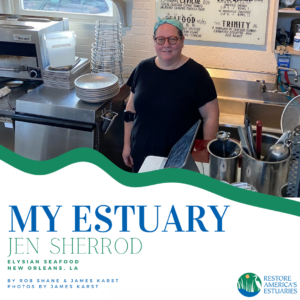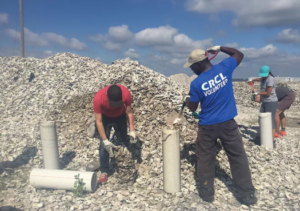
My Estuary: Jen Sherrod
 Seafood: The Soul of New Orleans
Seafood: The Soul of New Orleans
Jen Sherrod shucked her first oyster at the age of three and spent most of her young adult life working in restaurants along the Florida coast. When she left the Sunshine State in the 1990s to attend Loyola University Law School in New Orleans, she still yearned for fresh seafood and the buzz of the restaurant industry.
After graduating law school and passing the Louisiana bar exam, Jen realized that her calling was working in restaurants, and she quickly climbed the ranks to general manager at a prestigious Bistro in New Orleans. After more than a decade running the show, she was offered an opportunity that was too good to pass up.
When St. Roch Market opened its doors in 2015, Jen and her husband, Brandon, a classically trained chef, were invited to open a seafood concept in the new food hall. Thus, Elysian Seafood was born.
The shift to seafood gave Jen an opportunity to reconnect with her roots and pursue a culinary journey that was near and dear to her heart. The business has now expanded to include a busy catering operation and multiple locations.
One of the biggest keys to the success of Elysian Seafood? Partnerships.
There’s no denying New Orleans is one of the food capitals of the world. With the Gulf of Mexico right out its backdoor, having access to the best seafood, and in turn partnering with the best fishermen and women, the ingredients are all there for a successful restaurant. The Gulf is also fortunate enough to retain a healthy wild oyster fishery that Jen proudly taps into; at least 90% of the oysters she serves are sourced from wild stock in Louisiana waters.
In addition to partnering with local seafood harvesters, she also recognizes the importance of partnering with organizations doing restoration work, particularly the Coalition to Restore Coastal Louisiana (CRCL), Louisiana’s first statewide nonprofit dedicated to addressing coastal land loss. Through the organization’s Oyster Shell Recycling Program, local restaurants collect shell instead of discarding it with other trash. It’s then used to build oyster reefs that help to minimize coastal erosion and storm surge from hurricanes while at the same time creating habitat for new oysters, crabs, and numerous other species. The program has recycled more than 10 million pounds of shell since 2014, keeping it out of landfills and instead using it as a component of coastal restoration.
Elysian Seafood has been part of the program for about five years. In that time, Jen said, she’s donated more than 30 tons of shell to the program – all of which have been used to propagate new oyster growth and restore Louisiana’s coastal ecosystems.
This partnership is emblematic of the connection between the seafood that ends up on your plate at Jen’s restaurant and the need to restore our coastal ecosystems. You can’t have one without the other. Jen and many other business owners like her in New Orleans recognize this. More than dozen restaurants participate in the CRCL Oyster Shell Recycling Program, and similar programs have been operating successfully around the country, including in New York City and the Chesapeake Bay.
The connection doesn’t stop there, though. The Louisiana coast along the Gulf of Mexico is on the forefront of the battle against land loss and climate change. Threatened by the Mississippi River and hurricanes from the Gulf, the region has seen its fair share of devastation; and the economy is feeling this strain. Aside from damage from the storms themselves, changes in sediment loads and salinities in coastal wetlands have contributed to wide-ranging devastating effects that have led to the closure of businesses that depend on a healthy Gulf. More than 2,000 square miles of Louisiana’s coast have disappeared in less than a century.
Recognizing the uncertain future because of those and other threats, Jen sees in herself a requirement to also be a steward of the resource that her livelihood depends on. For the sake of sustainability, she must make a conscious decision about how many oysters she can responsibly sell at given times of the year, even if it means dipping into her own potential profits. When your restaurant sells between 10,000 and 12,000 oysters a month, this can be a difficult reality to face.
With more than 2/3 of America’s seafood harvest occurring in estuaries, restoration and conservation initiatives mean big bucks in the grand scope of local, regional, and national economies. In a recent report published by Restore America’s Estuaries, The Economic Value of America’s Estuaries, it was determined that the value of coastal blue carbon, or the ability of coastal wetlands to store and sequester carbon dioxide in soil, in the nearby Terrebonne Basin, with its more than 300,000 acres of wetlands, is estimated to be between $430 million to $2.5 billion. This wetland ecosystem is also one of the most threatened due to land loss, changes in salinity and uncertainty due to storms that are stronger and more frequent because of climate change.
 Luckily, government agencies and local organizations like CRCL are playing their part in ensuring the future health of the Gulf and, in turn, the future viability of the local economy.
Luckily, government agencies and local organizations like CRCL are playing their part in ensuring the future health of the Gulf and, in turn, the future viability of the local economy.
The National Oceanic and Atmospheric Administration (NOAA) is in the process of restoring 423 acres of marsh near Grand Lake, an effort that will stabilize shorelines and create new marsh habitat using dredge material from nearby lakes. The roughly $3 million project, which will be completed in 2023, has an overall long-range goal of creating and nourishing 1,000 to 2,000 acres of marsh habitat across seven miles of the Breton Basin just south of New Orleans.
Another NOAA project, in partnership with The Nature Conservancy, the Grand Isle and St. Bernard Shoreline Restoration, invested $4.3 million to protect 3.4 miles of vulnerable shoreline by constructing more than five acres of new oyster reef. Since its completion in 2012, more than 350 acres of emergent marsh have been protected, as well as the more than 100 estuary-dwelling species that depend on this habitat for survival.
Like Jen’s emphasis on partnerships, these efforts also rely heavily on partner organizations and agencies at the state level to design and implement restoration. They also put money on the ground in areas where coastal restoration has a ripple effect through the economy – from engineers and machine operators completing the work to the seafood harvesters and restaurants that reap the benefits of a healthy estuarine ecosystem.
 Looking ahead to the future of Louisiana’s seafood industry, a lot of questions remain unanswered. Between the Covid-19 pandemic and climate change-induced storms, some of Jen’s colleagues have been forced to close their doors or halt operations indefinitely. If the past few years are any indication, the increased regularity and volatility of these storms may be too much to outrun.
Looking ahead to the future of Louisiana’s seafood industry, a lot of questions remain unanswered. Between the Covid-19 pandemic and climate change-induced storms, some of Jen’s colleagues have been forced to close their doors or halt operations indefinitely. If the past few years are any indication, the increased regularity and volatility of these storms may be too much to outrun.
The solutions are available to us, though, and they are already working. Coastal restoration has proven to improve sustainable fishing opportunities while simultaneously improving coastal resiliency. If you look around St. Roch Market today, and you see the smiles on the faces of so many, it’s hard to imagine an outcome where New Orleans doesn’t win this battle. That’s what gives Jen optimism for the future of her business, and the many others like hers. The city is built on resiliency, and she has no reason to believe otherwise.
Thanks to Jen for letting us share her story. If you’re in New Orleans, be sure to grab some fresh oysters or make your next catering order from Elysian Seafood, operating 7 days a week at St. Roch Market. Learn more at elysianseafood.com and be sure to follow them on social media.
Rob Shane is the Communications Manager for Restore America’s Estuaries (RAE) based in Washington, D.C. You can read the full Economic Value of America’s Estuaries: 2021 Report at www.estuaries.org/economics – including the full case study on the Terrebonne Basin.
James Karst is the Communications and Marketing Director for the Coalition to Restore Coastal Louisiana (CRCL). CRCL is one of ten member organizations that make up RAE and the oldest statewide organization dedicated to coastal restoration in Louisiana, bringing together diverse voices and expertise to restore, protect, and advocate for the state’s most valuable resources.
